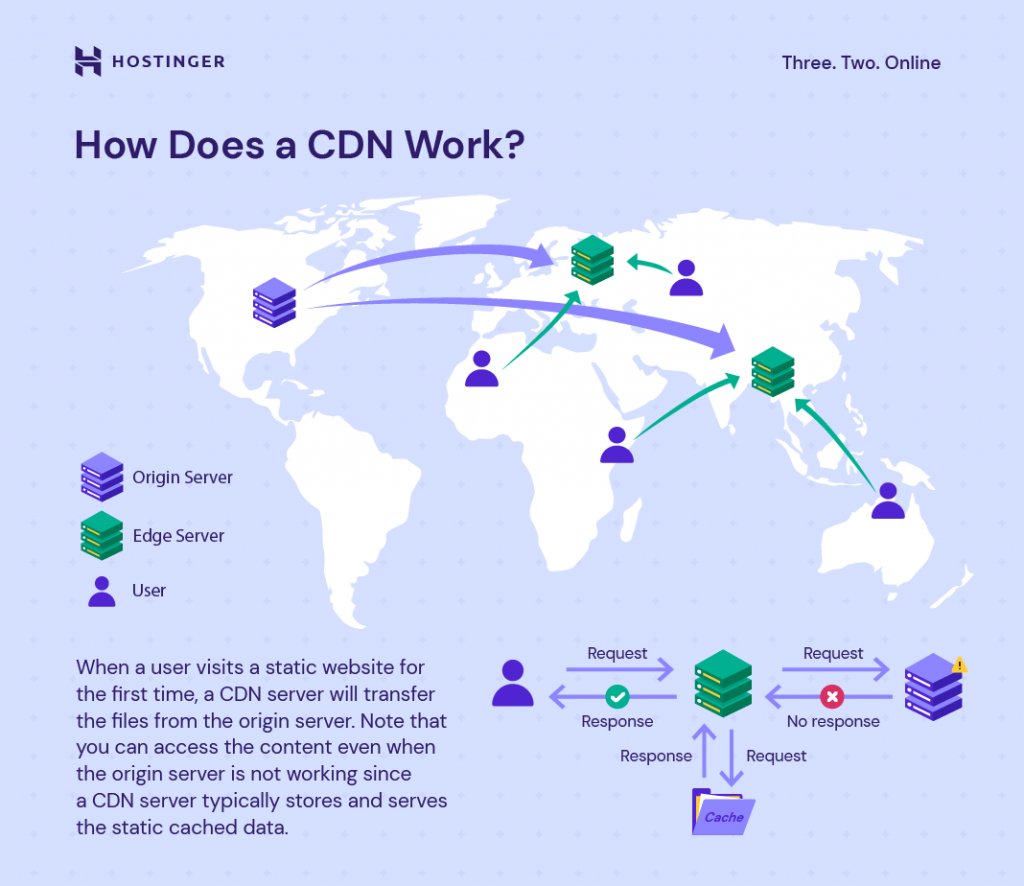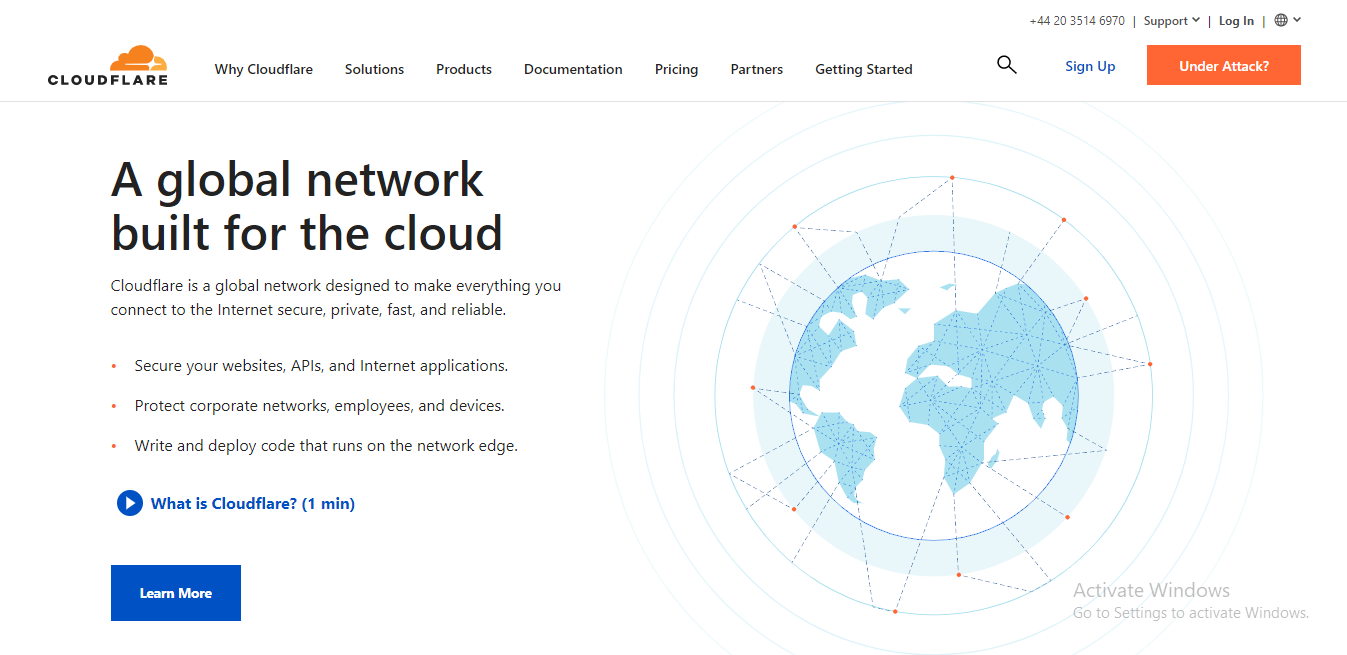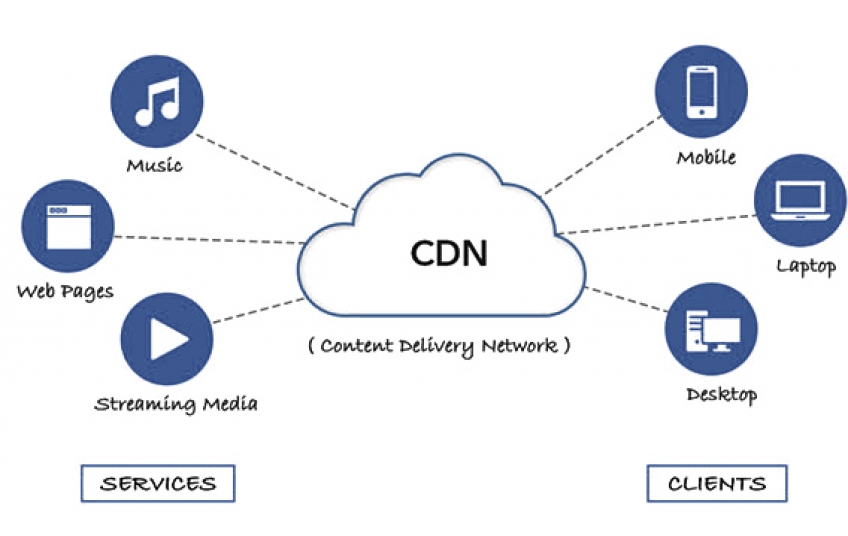A content delivery network (CDN) is a group of servers spread across different geographical locations worldwide to enable the quick delivery of a website’s content. It is also known as a content distribution network.
When a user connects to a website, the physical distance between them and the web hosting server affects the time it takes for the content to appear on the screen. In addition to reducing bandwidth consumption, the globally distributed network of data centers improves content delivery speed for users regardless of their location in relation to the main server.
To accomplish this, a caching system stores temporary copies of website files in the proxy server nearest to the user, speeding up the page load time.
If you are interested in learning about a CDN and how it works, this article may be right for you. We will discuss what a CDN is, how it works, its benefits, and how to choose the right CDN provider.
What Is a CDN? – Video Tutorial
Watch this video to learn what is a CDN (Content Delivery Network) and how it works.
How Does a CDN Work?
To learn how a CDN works, you must first understand what the origin and edge web servers are. An origin server is a computer hosting the original version of your website files.
On the other hand, an edge or a CDN server is a computer that can cache copies of web content retrieved from an origin server. Edge servers are located in physical data centers spread worldwide, forming a geographically distributed network.
A CDN’s benefits depend on the size of your site, the server’s location relative to your core traffic source, and the amount of traffic generated. For example, a local business with a physical location serving one small geographic area won’t gain much from a content distribution network.

However, if you’re an eCommerce business owner and need a wider reach or if your website generates heavy traffic from diverse global locations, a fast and efficient CDN will help you retain your competitive edge.
To help you understand the advantages of using a CDN, let’s compare the web content delivery process between two websites – one without a CDN and the one using it.
When a user accesses a website without a CDN, the browser connects to the origin server and requests site content. In addition to delivering the requested data, the origin server responds to each subsequent user request. Static files are cached locally on the user’s computer.
The entire process consists of the user sending requests to the origin server and the origin server responding by delivering website content. This procedure remains the same regardless of the user’s geographical location.
A problem arises when the end-user is far away from the origin server. The farther the distance between the two, the longer it will take for the page to load.
In addition, as the origin server handles all user requests, web performance may suffer when the workload increases due to traffic spikes.
On the contrary, when a user accesses a website with a CDN, the browser connects to and requests site content from one of the edge servers. The chosen server is usually the one closest to the end-user to reduce the time delay. The usage of multiple caching servers distributes traffic and prevents server overload.
The edge server will then forward the request to the origin server. After getting the data from the origin server, the edge server delivers it to the end-user and caches the files locally.
This means the edge server will serve all subsequent requests using the cached files without having to fetch data from the origin server again. The Internet content stored on the network edge can also be delivered to the end-user even if the origin server becomes inaccessible.
As such, using a CDN may lead to better web performance and user experience.
Understanding the CDN Services Through an Example
We will paint a hypothetical scenario to help you further understand the inner workings of a CDN.
Say you operate an online store based in the United States. Your eCommerce website is hosted on an origin server located in New York. This web server stores all of your website files.
Without a CDN, a customer accessing your website from Tokyo will most likely face a slow-loading site. This is because there is a large distance between the site visitor’s geographical location and your site’s origin server.
Using a CDN will speed up the page load times. With a CDN, when the Tokyo-based user requests content from your website, the browser will retrieve data from one of the CDN’s edge servers or points of presence spread worldwide, typically the one closest to the user’s location.
Connecting to a nearby CDN server decreases the distance between the user and the server, improving the content delivery speed.
Therefore, your site visitors will get to enjoy fast site speed regardless of their geographical location.
What Are the Benefits of Using a CDN?
To further explain why setting up a content delivery network is a crucial step in making a website, this section will discuss the advantages of using a CDN in more detail.
Reduce Bandwidth Consumption
One of the biggest expenses of web hosting is bandwidth costs. Reduce hosting costs by conserving the amount of bandwidth it takes to handle your traffic through the multiplication of points of presence.
A content delivery network uses optimization methods like caching, which involves placing static files into temporary storage on different computers for ease of access. These methods help reduce the overall server workload and bandwidth consumption.
Static content refers to the data delivered to the end-user without any modification. These files stay the same for all users, regardless of who requests them. Examples include media files like images and videos as well as HTML, CSS, and JavaScript files.
On the other hand, dynamic content is the data that cannot be cached on an edge server. This is because the content delivered may differ according to variables like user credentials or geographical locations. However, an advanced CDN’s network infrastructure and request-routing algorithms can help streamline the delivery of dynamic content.
In short, the combined technologies used by a CDN are useful for providing load balancing and reducing bandwidth costs.
Increase Overall Speed and Performance
One of the biggest contributors to high bounce rates is latency. This is the delay between a user connecting to a site and the web page content appearing on the screen. It usually happens due to the following reasons:
-
Delays in reading files due to blocked storage.
-
Setbacks in data processing from the web server.
-
Type of data transmission, such as a fiber-optic network versus coaxial cables.
-
Propagation, or the speed at which data travels from one node to another.
Many of these issues can be solved or heavily reduced by using an effective content delivery network. Implementing numerous website optimization strategies will also help improve site speed and performance.
Combined together, these efforts will also help search engines better understand your site. As a result, your ranking on search engine results pages (SERPs) will improve, increasing site traffic.
Improve Website Security
When all of the data transfer is conducted from a single web server, it increases your chances of being exposed to malicious events like Distributed Denial of Service (DDoS) attacks and other vulnerabilities.
DDoS attacks are coordinated requests for information conducted from multiple geographical locations and by different users at an appointed time. They can also be deployed automatically through bots. The purpose is to cause origin servers to crash due to web traffic overload. The intention behind such attacks may vary, from pure mischief to extortion and blackmail.
The attacks can continue for hours or even days, making the hacked website inaccessible. Using DDoS filters and spreading queries over several locations help mitigate these traffic explosions.
A CDN can also keep hackers out and protect sensitive data from cybersecurity attacks. This is achievable because CDNs deflect web traffic away from the original server to proxies, making the primary source practically invisible.
They also continually refresh SSL/TLS certificates to secure information transfers using data authentication and encryption. These certificates ensure data security protocols are followed by enabling only the intended recipient to access and view the information. When a website has an SSL/TLS certificate, the URL starts with https:// instead of http://.
You can purchase an SSL/TLS certificate or get one for free from trusted certificate authorities like Let’s Encrypt. Many web hosting providers also offer free SSL/TLS certificates as part of their plans. For example, all of Hostinger’s web hosting plans come with free SSL/TLS certificates.
Optimize Content Distribution and Availability
In addition to content delivery speed, content availability or redundancy is of the utmost importance. This refers to the act of making sure content stays accessible regardless of traffic or hardware failure.
Heavy traffic loads and hardware malfunction may result in downtime most websites simply can’t afford. Because a CDN’s traffic capacity exceeds that of origin servers, using one can help prevent interruptions to normal website function, ensuring a website stays online and can deliver content at all times.
By distributing traffic over multiple CDN servers, your core network infrastructure will have a lighter burden to carry. This system also ensures that in the case of some servers experiencing an outage, people can still access the website as other operational servers will handle the network traffic.
Here are some examples of who can get the most Internet content delivery benefits from a CDN:
-
eCommerce stores. These websites usually get heavy traffic loads and need to handle requests from many different locations. If the site fails to maintain content availability, the business can lose significant profit. A CDN can help prevent crashes on the server and improve page load time.
-
Advertising. Multimedia-based ads can have a wider reach than traditional methods of advertising. However, these ads also require lots of resources, which can result in poor website loading times. Advertising businesses can use CDNs to solve this problem and cache data closer to the end-user, making the content load much faster.
-
Online gaming. One of the biggest challenges for the online gaming industry is figuring out how to keep providing the best gaming experiences worldwide. CDN technology lets online games have “push zones”, meaning game developers can store large amounts of data on edge servers.
-
Entertainment. Content is the heart of the media and entertainment industry. Businesses like Netflix and Spotify rely on the process of delivering content quickly and efficiently to millions of people every day. Such services use CDNs to ensure quick web content delivery no matter where the end-users are located.
How to Choose a CDN Provider?
Different CDN service providers offer various features and benefits.

While some CDN providers offer services for free, others provide both free and premium DNS services. Known to be one of the most reliable CDN providers, Cloudflare falls into the latter category.
Some key elements to consider when browsing through different CDN services are your budget and requirements, including anticipated needs in the case of future growth.
The following is a list of features good CDN services should have:
-
Push or pull functionality. Web owners should be able to decide which caching method would best suit their type of website.
-
Origin shield. This feature acts as an additional caching layer between an origin server and the CDN edge servers, reducing the overall workload on the primary source.
-
Logging features. These allow users to search, store, analyze, and monitor the logging data and events from CDN providers.
-
Cache-control. This HTTP cache header allows users to determine how or when website resources should be cached alongside their expiration time.
-
Customization capabilities. Pick a service that lets you modify a CDN to suit your needs. For instance, some CDN providers give their users access to customize their asset delivery, SEO strategy, security measures, and mobile experience.
-
DDoS protection. Although a CDN can hide the origin’s IP address, you still need an additional layer of security to divert network-layer attacks, preventing hackers from potentially breaking into your website.
-
HTTP/2 support. Make sure the CDN supports HTTPS, which is much more secure and provides faster web performance than the regular HTTP protocol.
-
Diagnostics, analytics, and reporting. These tools are necessary to monitor an origin server’s overall health and optimize CDN configuration.
-
Geo-filtering. Specify paths on your CDN endpoint and determine rules to restrict certain web content based on location.





